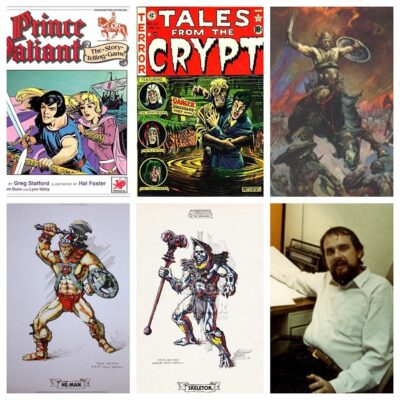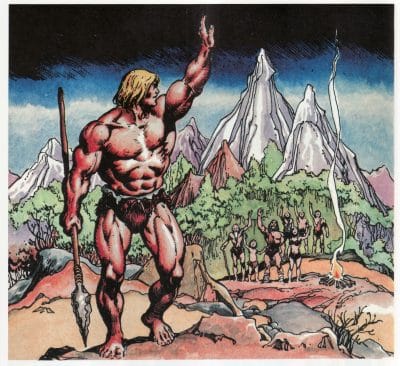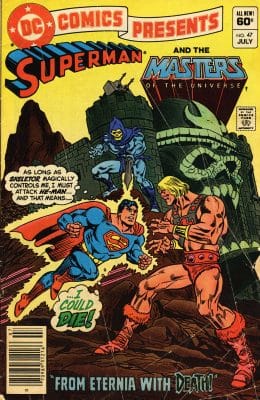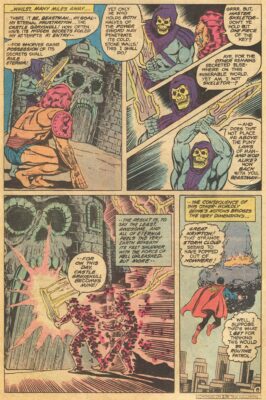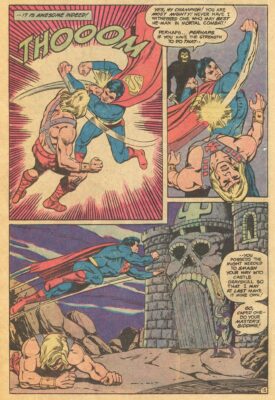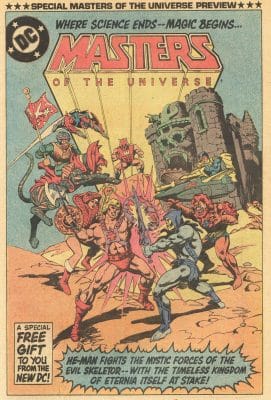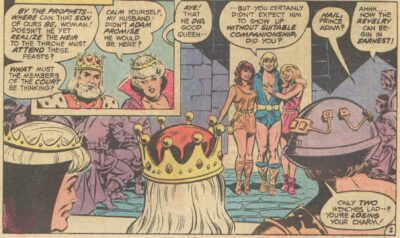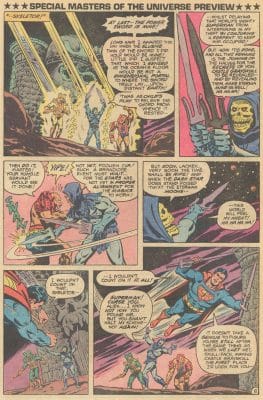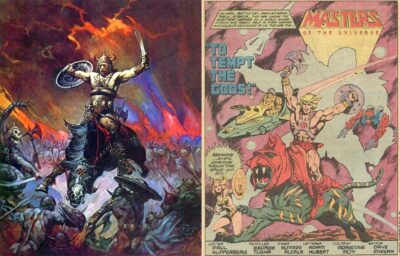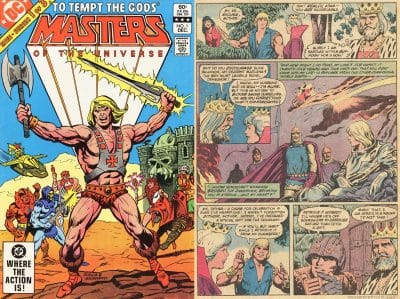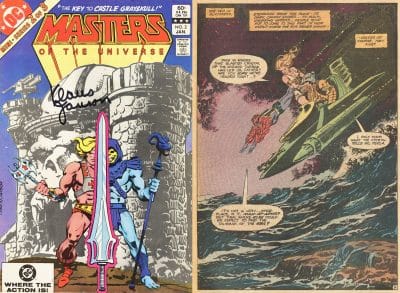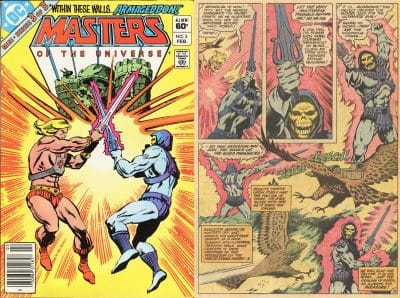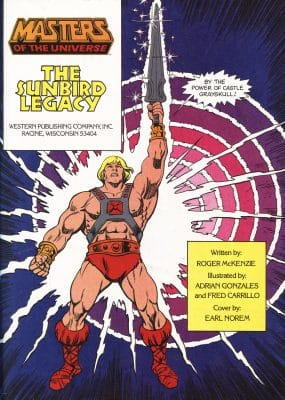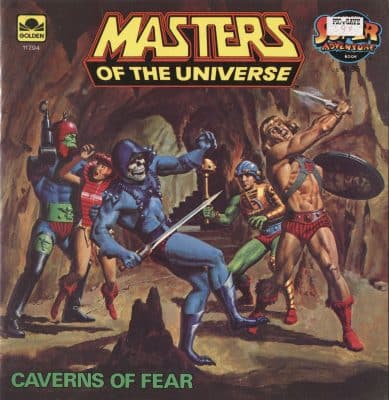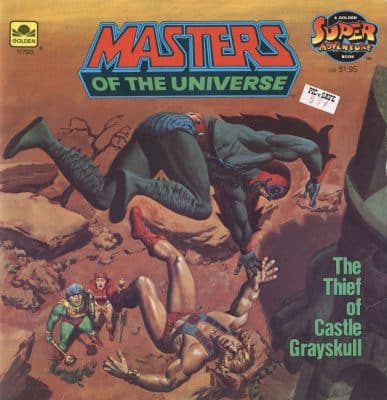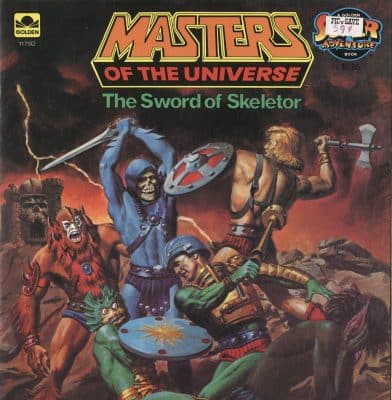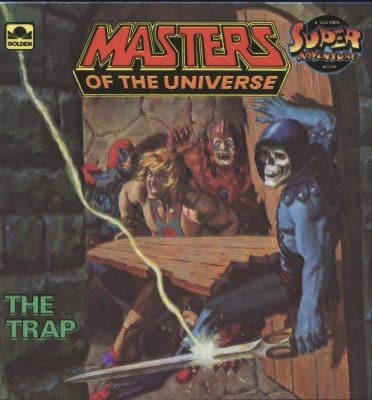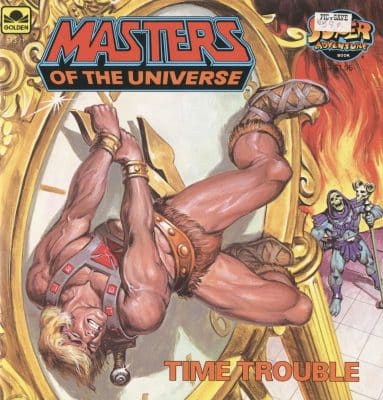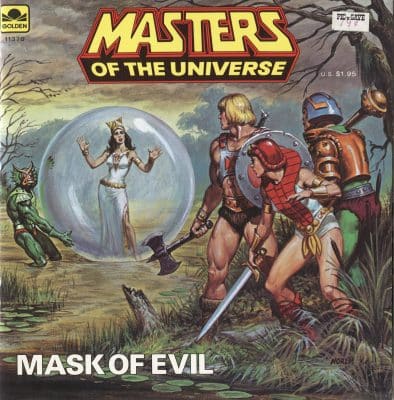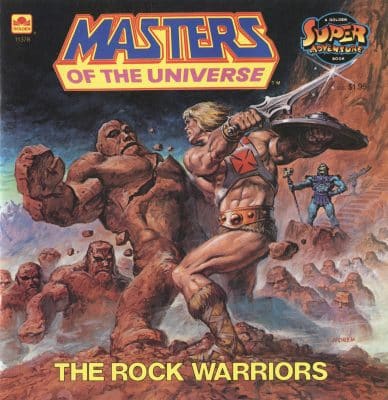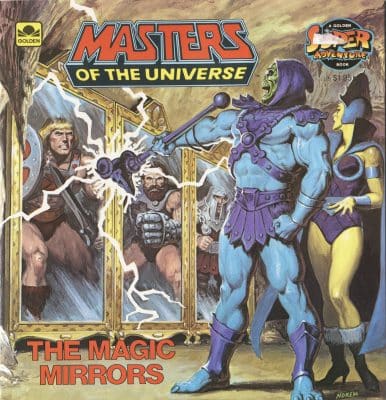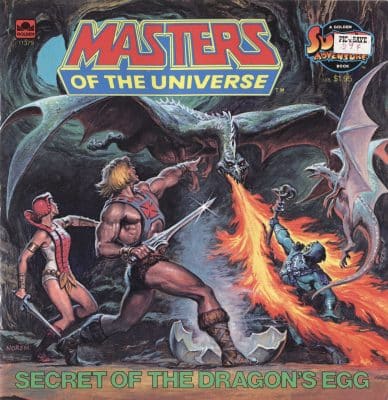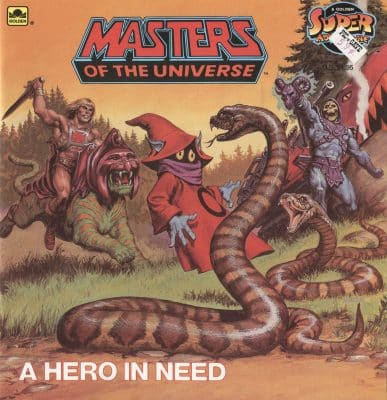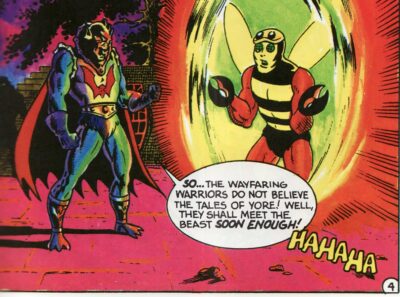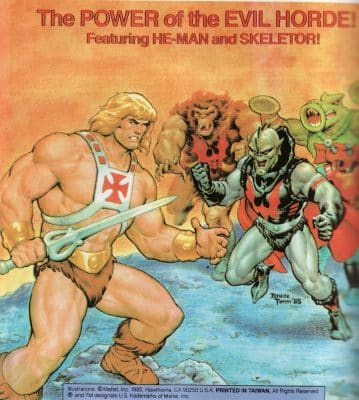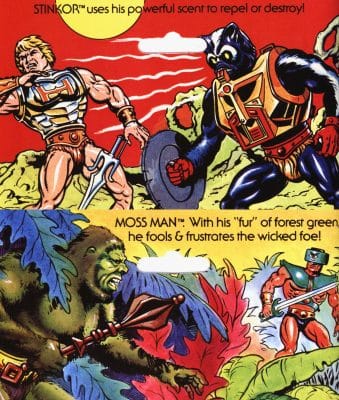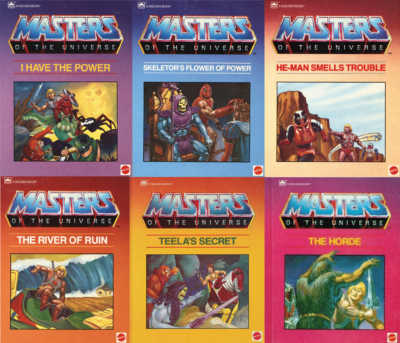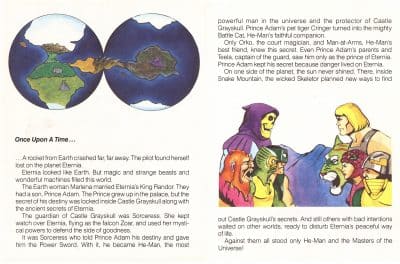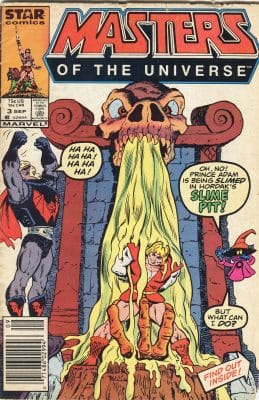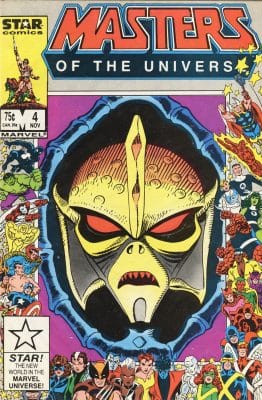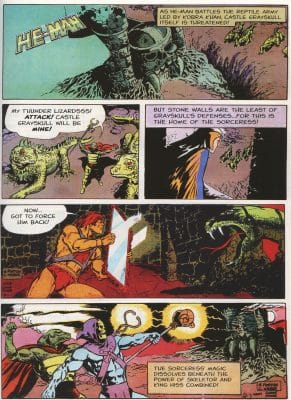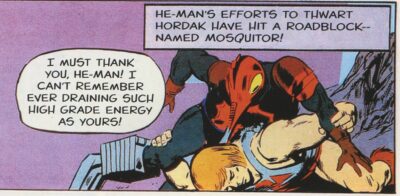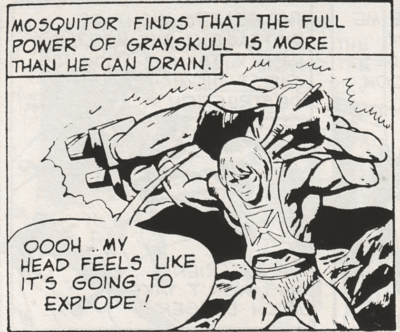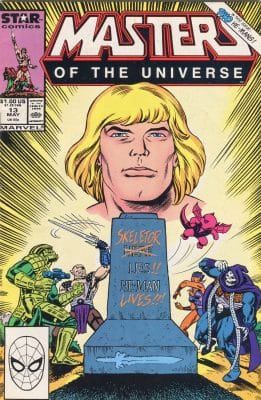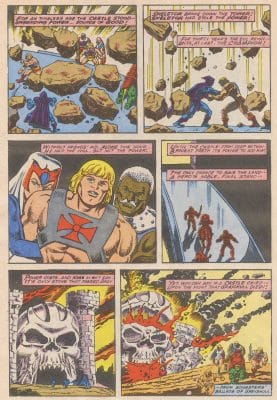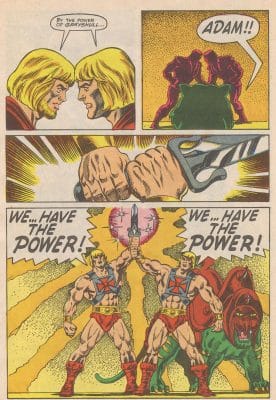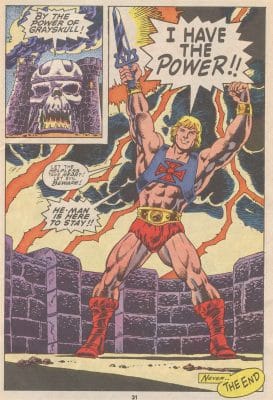Masters of the Universe Comics and Picture Books from the 1980s by Alex Grand
Read Alex Grand’s Understanding Superhero Comic Books published by McFarland Books in 2023 with Foreword by Jim Steranko with editorial reviews by comic book professionals, Jim Shooter, Tom Palmer, Tom DeFalco, Danny Fingeroth, Alex Segura, Carl Potts, Guy Dorian Sr. and more.
In the meantime enjoy the show:
He-Man isn’t an original name, it was used in a comic in the early 1950s as part of the Ziff-Davis line edited by Jerry Siegel, however that wasn’t a successful use of the name and Mattel used that name with far more cultural success in the early 1980s. Part of Mattel’s success with the He-Man toyline was its synergy with picture and comic books of the 1980s. These added much needed back story to give the toys meaning for the generation X kids that were eagerly wanting something fun to play with before video games became mainstream. Let’s walk through a fun timeline of Masters of the Universe books and comics of the 1980s. Mark Taylor is the illustrator designer that created the visual look of He-Man and the Masters of the Universe 1982-1987. He has said his influences were Hal Fosters Prince Valiant created in the late 1930s, EC Horror Comics early 1950s, and Frank Frazetta’s Conan paintings of the 1970s.
Donald Glut and Alfredo Alcala worked on Conan Magazine’s in the 1970’s which gave them perfect barbarian experience when Mattel had them make He-Man mini-comics accompanying the Toys starting in 1981. Here is He-Man’s first interior image. There was no Prince Adam, and he was part of a warrior tribe in Conan fashion set in a post-apocalyptic landscape. Conan Properties International sued Mattel over He-Man’s similarity to Conan, and that lawsuit went nowhere.
After the He-Man mini-comics were getting released in 1981, DC Comics also got a license to do He-Man comics and released a couple initial issues, the first one is DC Comics Presents 47, 1982 by Paul Kupperberg and Curt Swan. What makes these interesting is that these visuals and stories are very much aligned with the Donald Glut/Alfredo Alcala mini-comics but with more of the Prince Valiant side with a yet to be pink cartooned, Prince Adam. Man-At-Arms doesnt have a moustache yet, and the speech patterns of Eternians very much mimic a King Arthur type dialogue. He-Man also does not have a Power Sword yet, and instead as an already strong Prince Adam runs into the Sorceress’ Power Cave to put on the empowering He-Man devices that comprise his outfit. Skeletor has the purple half of the power sword which the other half is not yet discovered by anyone on Eternia. This is an interesting pre-Filmation He-Man which oddly enough answers pretty quickly who would win in a fight between He-Man and Superman.
DC Comics Presents 51, 1982 by Paul Kupperberg with art by Curt Swan/Dave Hunt continues the He-Man story started in issue 47. The Cover art to this preview story is loads of fun with the classic pre-Filmation aesthetic with an Arthurian type flag showing it is a bit advanced from the intial 4 mini-comics. However it is still very much grounded with Mer-Man scenes that harken to the adventures shown in those mini-comics a year earlier. Zodac premieres as a Kirby-like Metron type figure following the stars and signs to minimize the impact of Skeletor’s Evil, and in this continuity it was Superman who brought the other half of the power sword from Earth only to be lost again. Prince Adam is shown as a Bruce Wayne Playboy rather than a clutzy Clark Kent.
Zodac on his cosmic chair is reminiscent of Jack Kirby’s New God’s character, Metron from 1970.
When Mattel contracted Mark Taylor to draft He-Man, there was a corporate directive to get inspiration from the 1976 Conan the Conqueror Cover art by Frank Frazetta. George Tuska and Alfredo Alcala summon this in the interior splash page of DC’s Masters of the Universe 1, 1982.
Masters of the Universe 1, 1982 is the DC Mini-Series that came after He-Man’s two adventures in DC Comics Presents of the same year. Again, what makes this mini-series fun is that it is pre-Filmation, so He-Man is more of an adult barbarian story with the Arthurian influence in his Prince Adam Personae. Even Prince Adam again is a blue-clad playboy, rather than the pink clutz from the cartoon. George Tuska and Alfredo Alcala provide some very strong art considering it’s a licensed product, and it works well since Alcala drew the first four mini-comics a year earlier. The backstory of He-Man’s mother, the Queen being from Earth is established very quickly here.
Masters of the Universe 2, 1982 has beautiful pages like this one by George Tuska and Alfredo Alcala as He-Man’s team splits up, Man-At-Arms, Teela, and Stratos are about to dive deep into the Ocean to wage an attack on Mer-Man’s lair, the home of the Mer-People. Mer-Man routinely refers to his pagan God, Serpos.
DC Comic’s Masters of the Universe 3, 1983 ends the mini-series with both halves of the Power sword united and Skeletor empowered, with interiors of Castle Grayskull. Unfortunately this final issue of DC’s Pre-Filmation run did not have the inks of Alcala to give it that grounding into the mini-comics with that Barbarian look that he brought to Conan in the 1970s. The Klaus Janson inks on the cover are interesting however.
1983 was a big year for He-Man, mainly because his Filmation cartoon started and so merchandising and more picture comic books were soon to follow. Check out this hardcover comic book which also sports an Earl Norem Cover with a story by Roger McKenzie illustrated by Adrian Gonzales and Fred Carrillo. Similar to Giant Size X-Men 1 1975, the team splits up into various chapters each with their own locale until the final battle at the end united the various Masters of the Universe.
12 He-Man children books from many people’s childhood years of 1983-1986. These were produced by Golden Books sporting some really great Earl Norem covers. A couple covers were done by Gino D’Achille. Roger McKenzie wrote a couple of these memorable stories and Al McWilliams illustrated a couple. These are scans of covers from my childhood collection.
One of Bruce Timm’s earliest penciling works in comics was this first appearance of Hordak and the beginnings of his evil horde in this mini-comic 1984, a year before She-Ra’s first appearance. Hordak was from a dimension called the Fright Zone instead of the later She-Ra/Etheria storyline, and an antagonist to both He-Man and Skeletor.
Bruce Timm also created this He-Man piece in 1985 half a decade before his Batman animated series.
Rocketeer artist, Dave Stevens made some He-Man art for Mattel Toy Packaging circa 1985.
In 1985, Mattel has Toy Fans submit their own character designs for the Master of the Universe Toy Line, and kids were asked to call with their vote. Bruce Timm redrew the designs for this ad. Bruce Timm made the Batman Animated Series in 1992.
Not a comic book, but definitely picture books. Golden Book put out 6 Masters of the Universe picture books written by Bryce Korr and illustrated by Harry J. Quinn and James Holloway with creative and design direction by Jacquelyn A. Lloyd and Ralph E. Eckerstrom.
These were put out by Western Publishing in 1985 with an intro that centers on Marlena’s arrival to Eternia from Earth.
Many of us discuss the New Universe line from Marvel for mature readers, but they also had a kid friendly comics line called Star. Star Comics ran a licensed Masters of the Universe series from 1986-1987 penciled by Ron Wilson and written by Mike Carlin. This series was post-filmation and so the content wasn’t nearly as hard hitting as the 1982 DC series, but did have some nostalgic imagery like the Slime Pit. This is funny because Mattel had to pay out damages to parents suing for money to change their carpets after staining from this product. The other interesting cover was issue 4 which had Hordak surrounded by a frame of Marvel characters like other comics from that month of Nov 1986 celebrating Marvel’s 25 year anniversary.
The 1987 – 1991 He-Man Newspaper strip started out of a consolidation of writer-artist-editor talent from Filmation in cooperation with Mattel, which came together toward the end of the He-Man cartoon and the beginning of She-Ra. For the most part it was written by husband and wife team Chris Weber (writer) and Karen Willson (editor) and drawn by Gerald Forton. Connie Schurr colored the Sundays. It was popular globally until 2 years into its run when it was dropped in the USA from lack of popularity but continued in Europe and South America. It is seen as continuing the story from the Animated Cartoon which goes into an aging Man-at-Arms who meets his love and gets engaged to be married, Prince Adam better understands the boring responsibility of training to become a King, and there is a budding romance between Teela and He-Man who actually kiss. There is some exploration into Castle Grayskull and it delves further into the discovery of King Hiss of the Snake Men and the inner workings of Snake Mountain. Interviews with the writer-editor team show that Mattel had to approve every script submitted by the Filmation creative team on these strips.
Is this an episode of Caged Meat? No, it’s a daily from the 1987 He-Man Newspaper Strip when Mosquitor throws a muscular prisoner on the ground and gives him a good drain!
Here is a funny connection between 1987 Spaceball’s Prince Valium as a variant off of Prince Valiant just as Prince Adam was, and oddly enough, doesn’t that make the two blonde prince’s as creative offspring and brothers?
Masters of the Universe 13, 1988 is the final Marvel-Star He-Man comic book which ends with a bang. The DC line in the early 1980s was a mature rendition with some beautiful art, more in the line of the original 4 He-Man mini-comics. The Marvel-Star series was more geared for kids and were post-animation, with more camp. However the last 2 issues, especially this final issue goes much deeper into the backstory, in the Marvel style with Prince Adam giving up being He-Man to live a normal life. He travels to the future and finds that Eternia is under rule by Skeletor with Man-At-Arms murdered, Teela cold and jaded as the new sorceress, with his older self as an angry freedom fighter. Needless to say this all gets resolved with his friendship and parental bonds stronger than ever, but not without some sentimental moments. With only one sword of power, Adam and his older self hold up the sword and both become He-Man, the older He-Man fights the older despot Skeletor to the death with Castle Grayskull crumbling, and the lyrics to the cataclysmic page surprisingly paces well with the drama. Written by George Caragonne with art by Ron Wilson.
The last panel ends with a bang and we got a little sample of this in movie format in the 1987 Masters of the Universe Film with Dolph Lundgren.
Join us for more discussion at our Facebook group
check out our CBH documentary videos on our CBH Youtube Channel
get some historic comic book shirts, pillows, etc at CBH Merchandise
check out our CBH Podcast available on Apple Podcasts, Google PlayerFM and Stitcher.
Photos and images ©Their Respective Copyright holders
Masters of the Universe ©Mattel
Use of images are not intended to infringe on copyright, but merely used for academic purpose









